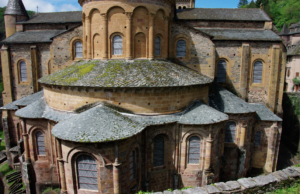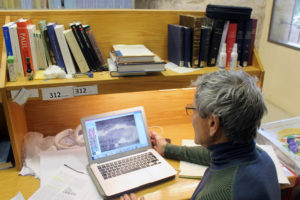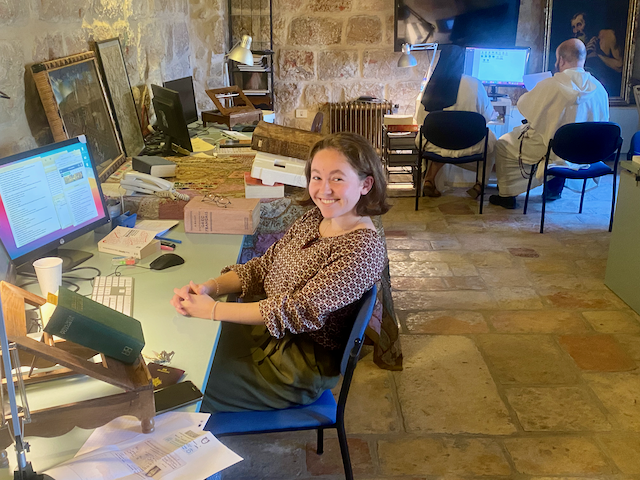Last Friday, March 6th, the École Biblique was in the spotlight at the Académie des Inscriptions et Belles-Lettres: the colloquium “Le goût de l’Orient” brought together members of both institutions at the Institut de France to celebrate the centenary of the recognition of the EBAF as an École archéologique française. Previous Orientalists included six former AIBL scholarship holders who came to testify about their academic year(s) spent at EBAF.
Find in this first article the speeches of Claire Balandier, archaeologist, lecturer in Ancient Greek World History at the University of Avignon, archaeologist, member of UMR 8210 AnHiMA (Anthropologie et histoire des mondes antiques), and director of the French Archaeological Mission in Paphos (Cyprus), and of Guillaume Bady, patrologist, research fellow at the CNRS, member of UMR 5189 HiSoMA (Histoire et Sources des Mondes Antiques), and director of the Institut des Sources Chrétiennes.
Speech of Mme Claire Balandier
Mr. Perpetual Secretary, Mr. President, Mr. Director, dear colleagues, dear friends,
It is a real honor for me to represent all the scholarship holders of the Academy of Inscriptions and Belles-Lettres at the École Biblique et Archéologique française of Jerusalem in the field of archaeology.
While the majority of the fellows came to Jerusalem to complete their doctoral thesis, I was already a doctor when I had the privilege of being chosen by the Académie des Inscriptions et Belles-Lettres to come and do post-doctoral research at the EBAF in 2002/2003. I had already had a foretaste of the Orient in Cyprus where I had been an assistant excavation worker since 1990 on the site of the École biblique of Athens on the walls of the kingdom-city of Amathonte and where I had completed my thesis on the fortifications and the defence of the territories of the island from the archaic period to the Arab invasions (8th century BC – 7th century AD). As a continuation of this research, it was logical to focus then on the neighbouring Levant, Herodotus’ Syria-Palestine, the Transeuphratene of the Achaemenid Persians and Syria-Phenicia of the Ptolemies.
I arrived in Jerusalem in October 2002. I still remember the light, sounds and perfumes that intoxicated me on the first morning when I passed the gate of the École to go to the Damascus Gate to discover the old city of Jerusalem. The impression that seized me was indescribable: although I had lived for more than two years in the Old City of Nicosia, which had accustomed me to the shouting and bustle of an eastern market, to the calls to prayer of the muezzins with whom the bells of churches of all denominations rivaled, to the political graffiti on the ancient walls concealed by jasmine and bougainvillea, to the passing of armed soldiers and groups of tourists unconcerned about passing through a city cut in two… everything, in Jerusalem, was more accentuated… and the same was true of the emotions felt, be it enthusiasm in the discovery of mythical and historical places or moral discouragement in the face of the daily difficulties that the Palestinians of the neighbourhood and the staff of the École, blocked at the “check-points” (there was not yet a separation wall between Israel and the West Bank), were experiencing. Indeed, very quickly, reality took over from wonder; we were in the middle of the second Intifada, the tension was palpable. Apart from the possibility of supporting the “women in black”, and also a few men, secular and religious of all religions, who demonstrated every Friday at noon, in the Place de France, in their desire for peace and their opposition to the colonisation and occupation of the Palestinian Territories, the painful feeling of powerlessness, the potential risk of attacks, and the impossibility of moving freely forced us to remain more than we would have liked within the secure walls of the EBAF. Selfishly, we have to admit that there were worse places to be confined and that it was far from unpleasant…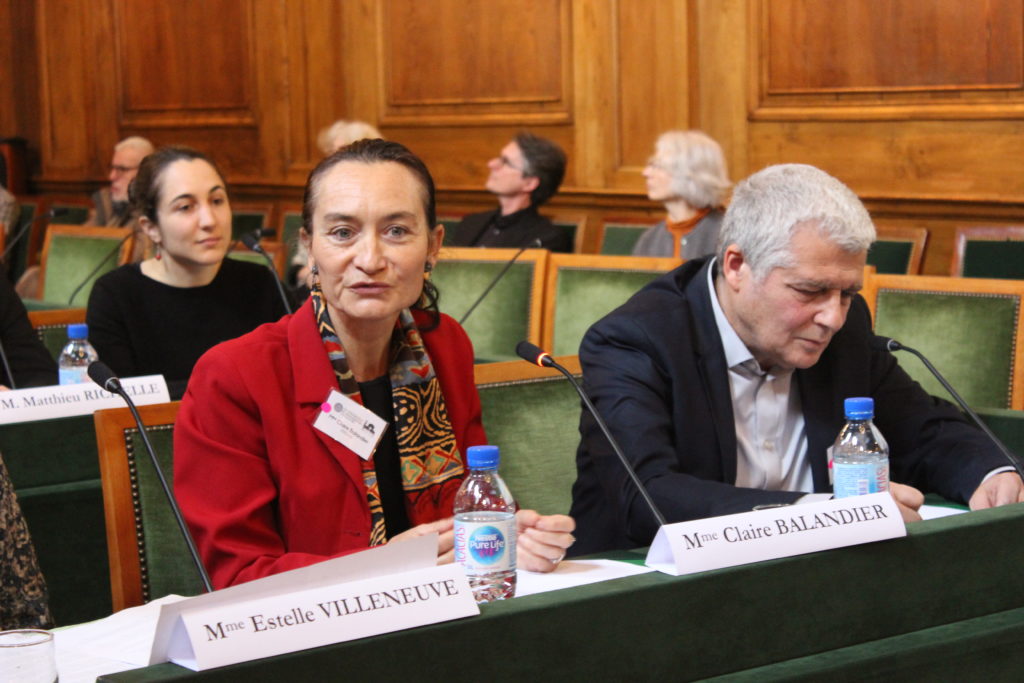
Like all the fellows, I followed a series of courses, each one more exciting than the last. Arriving with a background as a historian and archaeologist, I was particularly appreciative of the invaluable multidisciplinary teaching given at EBAF by Dominican biblical, historical, philological and archaeological teacher-researchers, who allowed me to refine the historical method I had learned at the university. In particular there were Francolino Gonçalvès’ courses in biblical exegesis on the books of the Kings, those of Étienne Nodet on the books of the Maccabees, Paolo Garuti’s courses in rhetoric, my introduction to Assyriology thanks to Marcel Sigrist, Emile Puech’s Qumranic studies, and literary Arabic taught by Krzysztof Modras. Above all, this study of texts, which could have been carried out anywhere, took on another dimension when supplemented by a study of archaeological sources, on the very material resulting from the excavations carried out by the École or in the Jerusalem museums at the Palestine Museum (Rockefeller) or the Israel Museum, and finally by the topographical approach to historical sites. I thus have exceptional memories of Jerry Murphy O’Connor’s courses in urban topography in the Old City of Jerusalem and those of Jean-Baptiste Humbert, and of the fascinating discussions held in the “Museum”, the building which, at the back of the École’s garden, serves as his research laboratory. Most of the archaeology fellows have had the opportunity to participate in the archaeological research conducted by the École, for a long time at Tell Keisan, the Citadel of Amman or Khirbet es-Samra in Jordan, in Gaza. When I arrived in the autumn of 2002, Jean-Baptiste Humbert was working in the Gaza Strip, on the site of Chati, rescuing a Hellenistic house whose lower walls, spared by bulldozers, were decorated with plaster painted in contrasting colours, yellow, black and red. The closure of the Gaza checkpoint abruptly interrupted this work and aborted the project to locate the route of the classic enclosure of the ancient city that Jean-Baptiste Humbert wanted us to carry out: I have a particular memory of the morning we spent walking along the dunes that covered the remains, caught between the increase in refugee camps and marine erosion. I regret that I was not able to be present when, in 2005, when work resumed, a gate from the Roman city walls was uncovered, and below that level, a gate from the Hellenistic period.
Travelling through the region is another fundamental part of the training offered by the École to the fellows. They last from one to several days and their objective is to discover the landscapes and sites evoked by biblical and historical texts. Following in the footsteps of the travellers who made us dream of the East, such as Chateaubriand, Renan, Lamartine and Pierre Loti, but above all in the footsteps of Fathers Jaussen and Savignac, Abel, but also Marcel Baudry (whom we did not have the honour of knowing, due to his premature and painful death, but whose memory was constantly evoked by his fathers and former students), these are unique experiences: despite the difficult political situation, it had thus been possible to visit the sites of Arad, Beersheba, and see the Byzantine cities of the Negeb desert and the crater of Ramon, on the Dead Sea, in Qumran, Ain Feshkha and Masada, on the coast, in Dor, Caesarea, St. John of Acre, in the Jordan Valley at Scythopolis and in Idumea at Lakish (Tell ed-Duweir). I retain a particular emotion from hiking in Wadi Qelt, from St. George’s Monastery to Jericho and in the Judean desert: walking and sleeping under the stars, like our illustrious predecessors, in the heart of an extraordinary nature, facing the elements, let us imagine the expeditions they had led in these long remote places, which allowed us to forget both contemporary civilization which is inexorably transforming the traditional life of the Bedouins, as well as the political and military tensions.
On the other hand, it was not possible for us to go to the West Bank because of the closure of the Territories under Palestinian Authority by the Israeli army. This seemed to jeopardize the research I had to conduct on the fortifications in this region, as field studies had become impossible. So it was mainly in the library that I spent my first year of research, relieved to find there all the archaeological journals and large collections that I could not consult in France, in particular all the reports of Jordanian, Palestinian and Israeli excavations, etc. During the second year, I was able to work more easily in the field for my research conducted further east, on the other side of the Jordan River, which, for the periods that interested me, was not a border but an artery of circulation and communication.
I was thus fortunate that both the Scientific Council of the École and the Académie des Inscriptions et Belles-Lettres were willing to accept my project to write a second year dissertation on the fortifications of Transjordan, which led me to spend a second year at the EBAF in 2003/2004. This also confirmed my desire to teach, to transmit a taste for the Orient and for research. Indeed, as I had guided trips to Greece in previous years, the then Director of the École, Jean-Michel Poffet, offered to take charge of the École’s trips and willingly accepted that I should precede them with courses in the historical and archaeological presentation of the sites we were going to visit, so that those who were discovering them for the first time could benefit from them. I greatly appreciated these rich moments of encounters, cultural and human exchanges.
We were asked whether the EBAF had a role in our professional career. It is undeniable. My entry into academia was made easier (it was clearly expressed to me that several members of the recruitment commission of the University of Avignon, where I was recruited as a Lecturer in Ancient Greek World History, appreciated that I was an EBAF graduate, thanks to the two dissertations that I had been able to write there and which had been presented to the Scientific Council of the École as well as to the Academy). A one-month stay at the École in January 2011 allowed me to visit the sites in the West Bank that were now accessible, despite the wall that had been erected since I left the École in July 2004.
I am very grateful to Francolino Goncalvès, then Head of Publications, for hosting this study in the new series of the Biblical Studies collection. The latter, whose recent death has caused us great sorrow, had responded positively to my invitation to come and speak about his work of exegesis at the research seminar of the University of Avignon. I still remember his enthusiasm in explaining his method about the Neo-Babylonian conquest of Judah and the bright eyes of the audience. A priori, the French archaeological mission that I was able to found in Paphos in 2008 thanks to the support of the Department of Antiquities of Cyprus and the Advisory Commission for Archaeological Research Abroad of the Ministry of Europe and Foreign Affairs had no connection with the EBAF. And yet, former scholarship holders have participated as excavators or are now our partners, Polish, in the framework of a four-year project funded by a European programme (Horizon 2020) and professors from the École have come to visit us there and participate in the first two international colloquia devoted to this site in Avignon in 2012, and then in Paphos itself in 2017. We also met again at recent scientific meetings organised by the Cyprus Research Institute in Nicosia, bringing together representatives of the French Archaeological Écoles and Institutes working in the Eastern Mediterranean. In fact, being a fellow at the École allowed me to establish intellectual and friendly links that are second to none, and to have the chance to rub shoulders with researchers from all horizons and especially with the older Dominicans, such as Father Emile Boismard or François Langlamet, grandees of the École, who had the pleasure of sharing with us, at table, their passion for their research, at times their doubts, their memories of “their” Palestine and “their” Orient, their enthusiasm, their disillusionment, and their hopes.
To conclude, in short, I will say that to be a former fellow of the Académie des Inscriptions et Belles-Lettres at the École Biblique et Archéologique Française de Jérusalem is to belong, in the final analysis, to a true scientific and human brotherhood.
Claire Balandier
Speech of M. Guillaume Bady
Mr. Perpetual Secretary,
Mr. Speaker,
Mr. Director,
Ladies and Gentlemen,
It is an honour for me to be called to represent, in some way, the fellows of the École Biblique in patristics—that is, the study of the Fathers of the Church or the Christian authors of the first centuries—in this place where I have maintained a vivid memory of the way in which Mr Jean Leclant received me at that time. I would also like to mention here Mr Antoine Guillaumont, who had written a report, which was very important to me, on the memoir I had written.
I was a scholarship holder at the Académie des Inscriptions et Belles Lettres in 1997-1998 and a student at the École Biblique when Fr. Claude Geffré was its director. As a student of Classics, I worked on some Greek Fathers. Not being an archaeologist at all, I was not at all good at gluing together shards, but the decalque, in ink, of mosaics for Jean-Baptiste Humbert allowed me to see that an ancient mosaicist could create a masterpiece without understanding anything of the Greek letters that he was copying – or rather that he was imitating them as if they were exotic animals. But that is the least of this year’s achievements. Gregory of Nyssa asked in the fourth century[1]: “What more shall he do who has gone” to Jerusalem?” The Cappadocian, even if he was shocked by the morals of Jerusalem and disillusioned after his setbacks there, nevertheless asked a good question.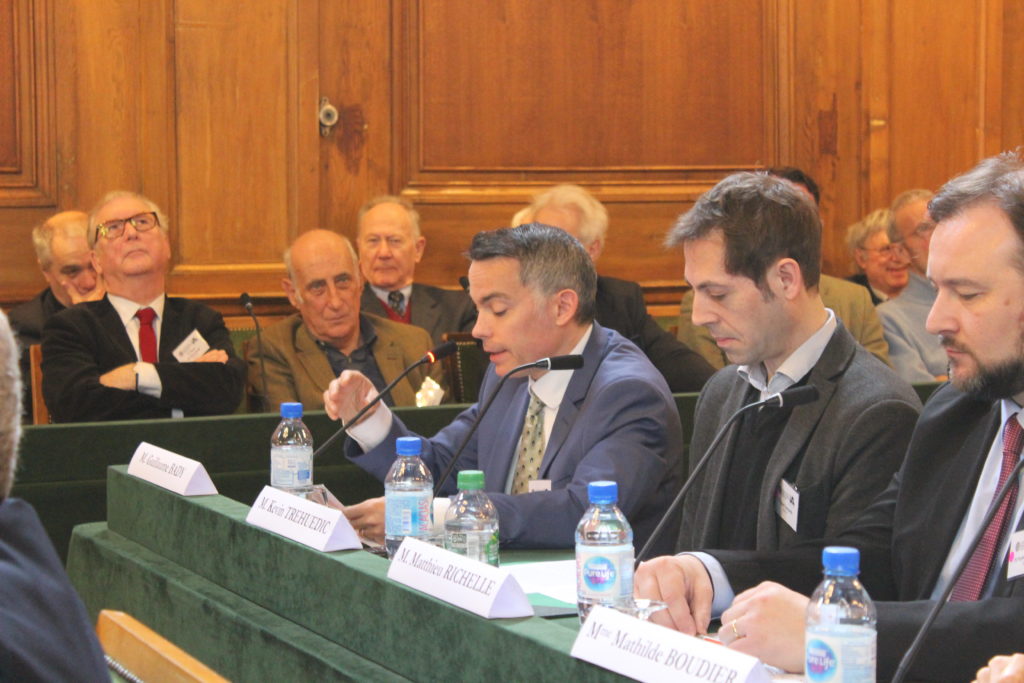
For me this year has been very positive, and even decisive, I have made many friends there—and yet I have never returned. On the one hand, the moments spent in the company of people in uniform at the airport or elsewhere, as well as the repeated attacks on civilians, made me want to never go through that again; on the other hand, I discovered, on my return to France, how much peace, being able to breathe in a country that is not continually at war, can be an absolutely priceless physical sensation. The first thing that this year at the École Biblique taught me was the concrete meaning of peace, seen in a Jerusalem that both crystallizes many conflicts and also shelters great diversity, the most astonishing religious coexistence that I have ever seen.
Apart from geopolitics, which was not on the program as such, the École Biblique helped me to discover biblical geography in a critical and lively way, with Marcel Beaudry as my guide. Thence it was impossible to read the Bible as before, without images, smells, a thousand impressions appearing in the pages.
Since the Bible is at the heart of patristics, Monique Alexandre at the Sorbonne strongly advised me, as she regularly did her students, to go to the École Biblique. And I liked it so much that at the end of the year, encouraged by Émile Puech, I even thought of going to Qumran – before the Fathers caught up with me and I was recruited as a researcher at the CNRS, assigned to the UMR HiSoMA, History and Sources of Ancient Worlds, more precisely to the Sources Chrétiennes, in Lyon, where I still work. Nevertheless, I have kept a kind of biblical bent. Recently a colleague pointed out to me – I hadn’t noticed it myself – that all my research revolves around the Bible. The Commentary on Proverbs attributed to John Chrysostom, the Lucian text of the Septuagint, the teaching, for more than 15 years, at the Institut Catholique de Paris on the Greek Bible – unfortunately the only introductory course that exists on this subject in France -, the introduction and annotated translation of 3rd Ezra in the New Ecumenical Translation of the Bible, some research on the ancient divisions of the Old Testament text… And I cannot fail to mention the Biblindex project, directed by my colleague Laurence Mellerin : this online index of biblical references among Christian authors of the first centuries, inherited from the Centre d’Analyse et de Documentation Patristique in Strasbourg. The database contains – a significant fact coming from patrologists – a fine concordance of 12 Bibles. Biblindex has also facilitated the monthly holding of a seminar for almost 10 years, whose papers are published in the Cahiers de Biblindex within the Cahiers de Biblia Patristica; Olivier-Thomas Venard has come to speak there and, since last year, he has been meeting regularly with the precise aim of providing the patristic annotation of the Ecclesiastes for the Bible In its Traditions.
For me, the notion that this way of studying the Bible, not by reading it simply as it appears today, nor by looking for a hypothetical original, but by taking an interest in its meaning in history, from ancient times, is more legitimate than ever. The success of the Lectures de la Bible du Ier au XVe siècle, a collective work published in 2017 under the direction of Laurence Mellerin, demonstrates this well. And this anchoring in history – not to mention the invaluable testimonies for the history of the text – is not the only interest of patristic and medieval writings on the Bible. In my opinion, patristic traditions also make it possible to rebalance and reorient: a rebalancing on the side of Judaism and the Old Testament, which in relation to our times was much more cited by the Fathers than the New (even today, if ambitious projects are still underway for an exhaustive survey of the patristic lessons of the New Testament text, only a handful of courageous people set about editing the Septuagint), and a more uncomplicated reorientation towards an updated meaning of the Scriptures, that is, no longer just from a more or less fantastical Urtext, but because updating has always been part of the text itself.
Is not this centenary of the École biblique a perfect opportunity to make more topical than ever the study of the Bible, which is the origin and the very aim of its creation? For I say it today with immense gratitude: the École Biblique has contributed to making the Bible current, and even, in a way, without end.
Guillaume Bady
[1] French source: Lettre 2, 8, trad. P. Maraval, SC 363, p. 115.
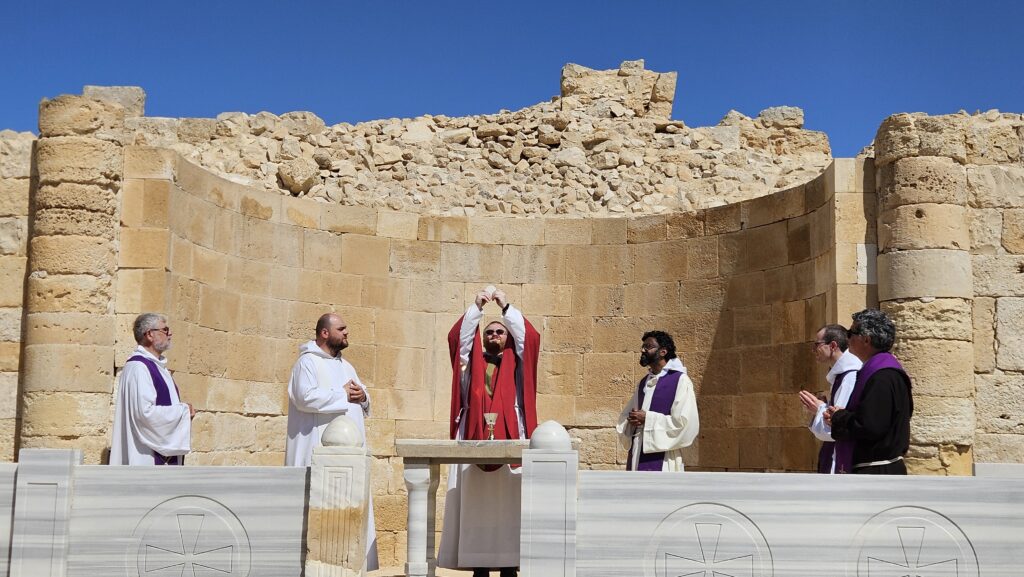 Photo: ÉBAF, Ordo Prædicatorum. Divine mass presided by Fr. Leo in the Negev desert.
Photo: ÉBAF, Ordo Prædicatorum. Divine mass presided by Fr. Leo in the Negev desert.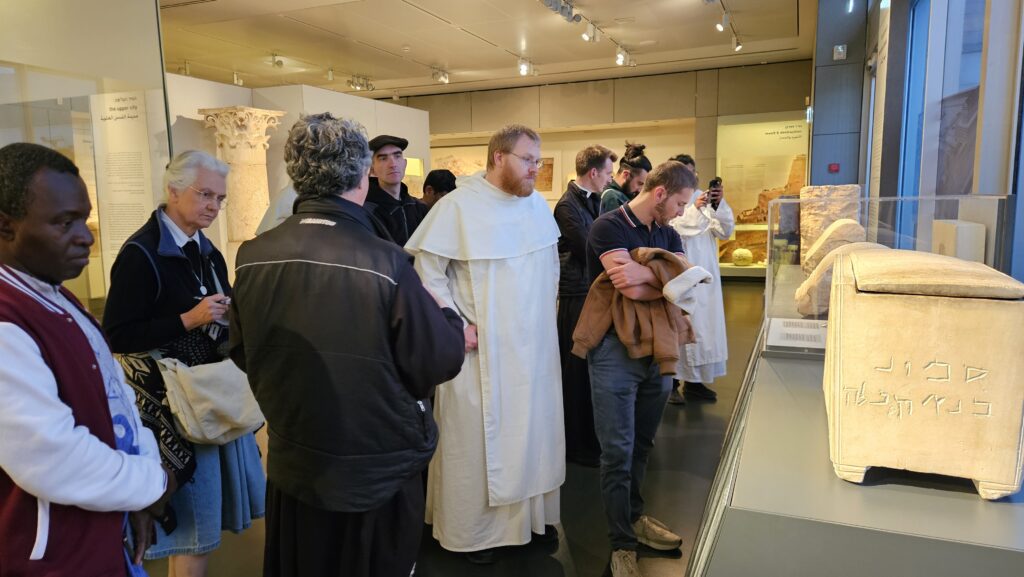 Photo: ÉBAF, Ordo Prædicatorum. Topography class in the Israel Museum, Jerusalem.
Photo: ÉBAF, Ordo Prædicatorum. Topography class in the Israel Museum, Jerusalem.

